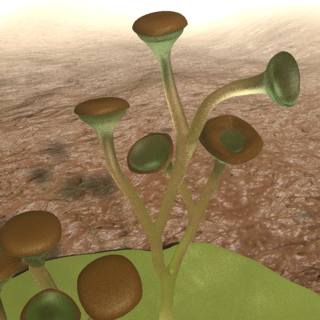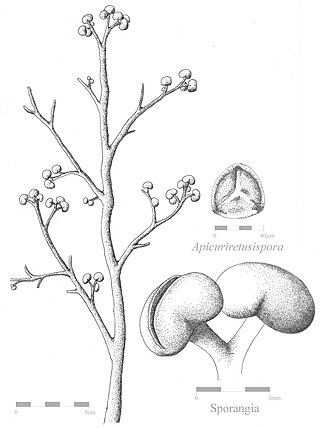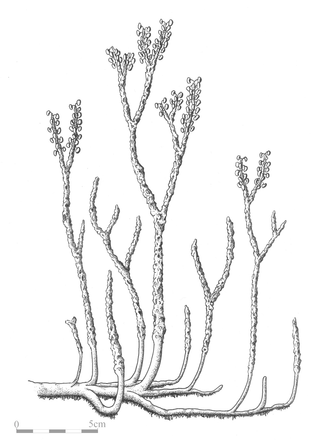
In biology, a spore is a unit of sexual or asexual reproduction that may be adapted for dispersal and for survival, often for extended periods of time, in unfavourable conditions. Spores form part of the life cycles of many plants, algae, fungi and protozoa.

Cooksonia is an extinct group of primitive land plants, treated as a genus, although probably not monophyletic. The earliest Cooksonia date from the middle of the Silurian ; the group continued to be an important component of the flora until the end of the Early Devonian, a total time span of 433 to 393 million years ago. While Cooksonia fossils are distributed globally, most type specimens come from Britain, where they were first discovered in 1937. Cooksonia includes the oldest known plant to have a stem with vascular tissue and is thus a transitional form between the primitive non-vascular bryophytes and the vascular plants.

Tortilicaulis is a moss-like plant known from fossils recovered from southern Britain, spanning the Silurian-Devonian boundary. Originally recovered from the Downtonian of the Welsh borderlands, Tortilicaulis has since been recovered in the famous Ludlow Lane locality.

Psilophyton is a genus of extinct vascular plants. Described in 1859, it was one of the first fossil plants to be found which was of Devonian age. Specimens have been found in northern Maine, USA; Gaspé Bay, Quebec and New Brunswick, Canada; the Czech Republic; and Yunnan, China. Plants lacked leaves or true roots; spore-forming organs or sporangia were borne on the ends of branched clusters. It is significantly more complex than some other plants of comparable age and is thought to be part of the group from within which the modern ferns and seed plants evolved.

Polysporangiophytes, also called polysporangiates or formally Polysporangiophyta, are plants in which the spore-bearing generation (sporophyte) has branching stems (axes) that bear sporangia. The name literally means 'many sporangia plant'. The clade includes all land plants (embryophytes) except for the bryophytes whose sporophytes are normally unbranched, even if a few exceptional cases occur. While the definition is independent of the presence of vascular tissue, all living polysporangiophytes also have vascular tissue, i.e., are vascular plants or tracheophytes. Extinct polysporangiophytes are known that have no vascular tissue and so are not tracheophytes.
Hostinella is a form genus, used for bare dichotomously branching stems (axes) which have not been found in association with spore-forming organs or sporangia and so cannot be assigned to a more precise genus or species. Specimens assigned to this genus have been found in Bathurst Island, Canada, in the Bertie Formation of Upper Silurian age, where the stems are approximately 1.2 mm in diameter; and in Lower Devonian Senni beds where the axes have a straited external appearance and contain xylem with tracheids.

Salopella is a form genus for small fossil plants of Late Silurian to Early Devonian age. The diagnostic characters are naked axes branching isotomously, terminating in fusiform sporangia. The sporangia are unbranched, but in at least the type species the axes seem to branch just under the sporangia. It differs from the similar form genus Tortilicaulis in that the sporangia do not have spirally arranged cells, and from other similar form genera such as Cooksonia, Uskiella and Tarrantia in the shape of the sporangia.

Renalia is a genus of extinct vascular plants from the Early Devonian. It was first described in 1976 from compressed fossils in the Battery Point Formation. It is difficult to reconstruct the original form of the complete plant, but it appears to have consisted of leafless branching stems whose side branches had sporangia at their tips. It is regarded as an early relative of the lycophytes.
Huia is a genus of extinct vascular plants of the Early Devonian. The genus was first described in 1985 based on fossil specimens from the Posongchong Formation, Wenshan district, Yunnan, China.
Distichophytum is a genus of extinct vascular plants of the Late Silurian (Ludfordian) to Early Devonian (Emsian), around 426 to 393 million years ago. The genus has a tangled taxonomic history, also being known as Bucheria and Rebuchia.
Hsua is a genus of extinct vascular plants, known from the Devonian. The name of the genus honours the Chinese palaeobotanist, Jen Hsü (徐仁).
Fusitheca was a genus of land plant with branching axes. It is known from charcoalified Early Devonian deposits, its type locality being the Brown Clee Hill lagerstätten. Its spores form smooth-walled, unfused, naked dyads. Its axis comprises length-parallel filaments, and their dichotomies are T-shaped, with the branches bending to continue upwards.
Culullitheca was a genus of land plant with branching axes. It is known from charcoalified Early Devonian deposits, its type locality being the Brown Clee Hill lagerstätten. Its spores formed permanent dyads.

Nothia was a genus of Early Devonian vascular plants whose fossils were found in the Rhynie chert in Scotland. It had branching horizontal underground stems (rhizomes) and leafless aerial stems (axes) bearing lateral and terminal spore-forming organs (sporangia). Its aerial stems were covered with small 'bumps' (emergences), each bearing a stoma. It is one of the best described early land plants. Its classification remains uncertain, although it has been treated as a zosterophyll. There is one species, Nothia aphylla.
Aberlemnia is a genus of extinct vascular plants of the Early Devonian, which consisted of leafless stems with terminal spore-forming organs (sporangia). Fossils found in Scotland were initially described as Cooksonia caledonica. A later review, which included new and more complete fossils from Brazil, showed that the specimens did not fit the circumscription of the genus Cooksonia; accordingly a new genus Aberlemnia was proposed.
Catenalis is a genus of extinct plants of the Early Devonian. Fossils were first found in the Posongchong Formation of eastern Yunnan, China. The leafless stems (axes) bore 10-12 elliptical spore-forming organs or sporangia on side branches. To release their spores, the sporangia split at the opposite end to their attachment to the stem. Its phylogenetic relationship to other land plants is considered uncertain at present.
Celatheca is a genus of extinct plants of the Early Devonian. Fossils were first found in the Posongchong Formation of eastern Yunnan, China. The leafless stems (axes) divided dichotomously but unequally so that one branch formed more of a 'main' stem and the other a side branch system. Side branches which did not bear spore-forming organs or sporangia divided two or three times further, ending in tips which curled back on themselves. Side branches bearing sporangia ultimately divided to produce a group of four sporangia, each with an outer leaf-like bract which folded around the sporangium. Celatheca resembles the Australian fossil Yarravia.
Demersatheca is a genus of extinct vascular plants of the Early Devonian. Fossils were first found in the Posongchong Formation of eastern Yunnan, China. The plant had smooth leafless stems at least 1 mm in diameter, but only regions which bore spore-forming organs or sporangia are well-known. Sporangia were borne in 'spikes' or strobili, at least 40 mm long; one had 32 sporangia. Sporangia were arranged in four rows, two sporangia being opposite to one another on the stem with the next two being at right angles. Each sporangium consisted of two 'valves' which opened at the top to release their spores. A particular feature of Demersatheca which distinguishes it from other zosterophylls is that the stalk-less sporangia were sunken into the stem of the spike, so that the outer valve was flush with the surface.
Halleophyton is a genus of extinct vascular plants of the Early Devonian. Fossils were first found in the Posongchong Formation of eastern Yunnan, China. The plant had leafy aerial stems. The leaf bases completely covered the stems forming rhomboidal to hexagonal patterns, except where spore-forming organs or sporangia were present where the leaves thinned out somewhat. The tapered undivided leaves curved inwards and appear to have had a central vein. The sporangia were mixed with leaves and were more-or-less circular in outline, consisting of two valves which split to release the spores. Halleophyton has similarities with Drepanophycus, but a lack of detailed knowledge of some features of that genus persuaded Li and Edwards to create a new genus for their specimens. Although considered to be related to the lycophytes, the exact placement of the genus was left open by its authors. Hao and Xue in 2013 listed the genus as a lycopsid.
Yarravia is a genus of extinct vascular plants mainly known from fossils found in Victoria, Australia. Originally the rocks in which they were found were considered to be late Silurian in age; more recently they have been found to be Early Devonian. Specimens consist only of incomplete leafless stems, some of which bore groups of spore-forming organs or sporangia which were fused, at least at the base.








